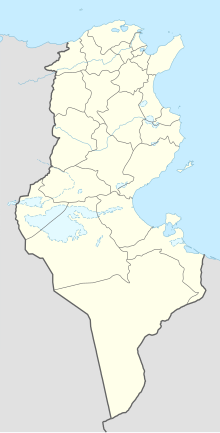Thapsus
Coordinates: 35 ° 37 ′ 33 ″ N , 11 ° 2 ′ 42 ″ E
Thapsus (Greek form Thapsos ) was an ancient city on the coast of North Africa in what is now Tunisia. It was one of many towns on the Byzacena coastline and originally a Phoenician market town founded near a salt lake , 80 stadia from the island of Lopadussa, between Leptis Minor and Sullectum.
After the Third Punic War and the destruction of Carthage, Thapsus belonged to the Roman province of Africa , but retained its internal autonomy as a civitas libera .
In 46 BC Chr. Found here the Battle of Thapsus between Julius Caesar and the united army of followers of Pompey and the Numidian king Juba instead.
During the fall of the Roman Empire , the Vandals came here from Spain around 430 and the land came to their kingdom.
The only bishop known by name is Vigilius von Thapsus , who took part in a bishops' conference in 484 at the time of the Arian church division. It was convened by the Vandal King Hunerich as a platform for discussion between the Nicene bishops and those of the Arians supported by the king . When the conference failed, Hunerich issued an edict to dispossess and banish the Nicene people if they did not become Arian. Vigilius also seems to have fled - probably to Constantinople ; only ten to twenty years later were Nicene allowed to return under a later king.
Thapsus is still a titular bishopric today .
When the climate in North Africa deteriorated, the city fell into disrepair; its ruins can be found at Ras Dimas , near Bekalta in Tunisia . You can still see the remains of a pier , a fort , an amphitheater and large cisterns . In the surrounding area there is a necropolis of the Carthaginians .
